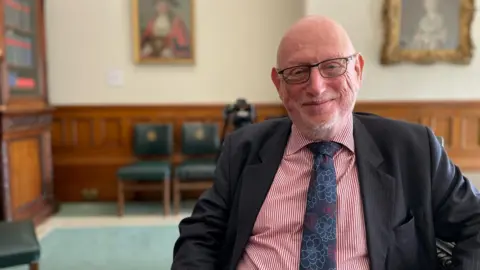 BBC
BBCBirmingham City Council owns an artwork collection valued at almost half a billion pounds, a BBC investigation has discovered.
But none will be sold off to help tackle the financial challenges at the council which declared it was effectively bankrupt last year.
The commitment to preserve the collection was made by the council’s leadership despite the need to plug a £300m hole in the council’s budget over two years.
Residents in the city have already seen cuts to services and a council tax rise of 10% this year, with another planned from April 2025.
There were no proposals to sell any artworks and many of them were gifts to the city from donors who wanted them on public display, a council spokesperson said.
“These are not regular council assets but artworks within an accredited museum so there are major implications and complications even if we wished to consider this,” they added.

The council also said any sales could have implications for Birmingham Museums Trust which is responsible for most of the artworks, with grant funding potentially at risk.
Having initially refused to supply the value of the publicly owned art collection to the BBC, the Information Commissioner’s Office ordered the council to reveal the £451m value under the Freedom of Information Act.
The scale of the council-owned art collection was also revealed and included 1,430 paintings, 560 sculptures and 25,924 works on paper as of January.
But just 1% of the artwork, 329 pieces, was on display at that time.
The percentage is expected to rise significantly as Birmingham Museum and Art Gallery’s phased reopening gathers pace from October, the venue having been largely closed for refurbishment since 2020.
In a previous statement about the reopening, Sara Wajid and Zak Mensah, co-chief executives at Birmingham Museums Trust, said they were looking forward to welcoming visitors this October half-term.
“It’s such an important institution for the people of Birmingham and we’ve made those people central to the new displays that you will all be able to see,” they added.
 TIMEWISE
TIMEWISESerena Trowbridge, chair of The Pre-Raphaelite Society in Birmingham, said the collection was a crucial part of Birmingham’s heritage and that it was considered to include the world’s finest collection of pre-Raphaelite art.
“It’s a real part of the city’s history and of the city’s people,” she said.
“I think to hang on to that, to make that available and accessible to people, is hugely important.
The collection includes works from Edward Burne-Jones’ Pygmalion series, works by Dante Gabriel Rosetti as well as John Everett Millais’ piece The Blind Girl and Ford Madox Brown’s painting The Last of England.
“These are actually really important for the people of Birmingham, for their morale and how they feel about things,” Ms Trowbridge added.
“I don’t think they’re ours to sell, they belong to future generations.”
The decision not to sell off artworks was backed by the council’s Lead Commissioner Max Caller, who has been brought in to oversee the financial recovery of the council.
That is despite commissioners’ comments published this week which warned the council did not “have sufficiently robust plans to balance the budget in 2025-26 and subsequent years”.
The move to protect the art collection was also backed by a former deputy leader of the council, Liberal Democrat councillor Paul Tilsley CBE, who described its value to the city as “immeasurable”.
Asked whether keeping the entire art collection was the correct decision when there have been cuts to core services across the city, he said: “You have to take a community in the round and the quality of life includes its culture.”
Reacting to the BBC’s story, Joanna Marchong from low-tax pressure group The TaxPayers’ Alliance said the financial situation faced by the council was scary.
“There are people at stake here, and it’s only really residents and taxpayers that will be the ones picking up for [the council] if they’re not making active decisions themselves,” she said.
She added that her organisation had concluded Birmingham City Council had acquired 61 new pieces of artwork in the last three years.
“If we don’t put our foot down now, who’s to say that they will always view artwork as a priority instead of actually delivering frontline services and helping the people that truly need it,” she said.


